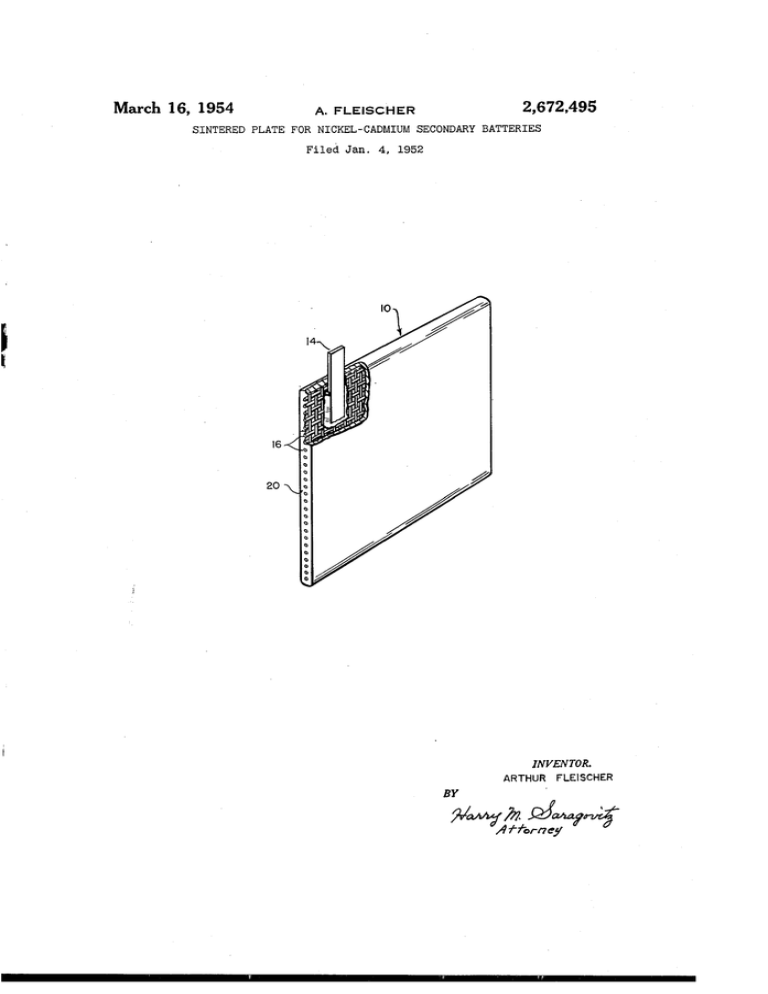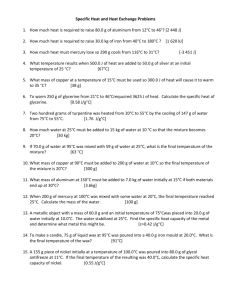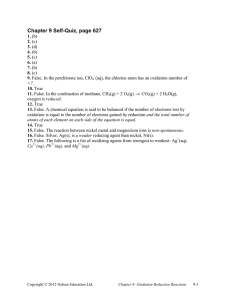ffor?ejl
advertisement

March 16, 1954 2,672,495 A. FLEISCHER SINTERED PLATE FOR NICKEL-CADMIUM SECONDARY BATTERIES Filed Jan. 4, 1952 . 1.!an 2o INVENTOR. ARTHUR FLEISCHER BY ffor?ejl y Patented Mar. 16, 1954 2,672,495 UNITED STATES PATENT OFFICE 2,672,495 SINTERED PLATE FOR NICKEL-CADMIUM SECONDARY BATTERIES Arthur Fleischer, Northampton, Mass., assignor to the United States of America as represented by the Secretary of the Army Application January 4, 1952, Serial No. 264,975 7 Claims. (Cl. 136—28) 1 2 The present invention relates to secondary nickel-cadmium batteries of the sintered plate type and more particularly to improvements in the construction of the sintered plates of such batteries. about 30% by weight of graphite. In another There are three known types of nickel-cadmium batteries. The tubular type (similar to the nickel iron Edison batteries), the ?at plate construc tion (pocket type), and the sintered plate con and preferred form, the sintered plate has a porosity of about 80% (corrected for the presence of a grid). This invention further provides in a nickel cadmium secondary battery, a sintered plate con taining a. major portion of nickel and a minor portion of graphite. The material is usually formed and sintered about a nickel plated screen struction. - The principal difference between the 10 grid in such a manner as to ?ll all of the inter sintered plate construction and the others is that stices within the grid and to cover all of the ex posed surfaces of the grid. The process of pre the sintered plate carries the active material in place of the grids of tubular and pocket construc paring a sintered plate from the herein disclosed nickel-graphite mixtures is also a part of this tions as used in the other types of batteries. The sintered plate construction provides more surface 15 invention. Natural graphite is preferred for use with which to carry the active material than the in this invention. The invention will be more clearly disclosed other types of constructions and is more highly with reference to the appended drawing, wherein desired. the ?gure shows a perspective section view of a sintered plate nickel-cadmium batteries are characterized by greater mechanical strength and 20 sintered battery plaque in accordance with this more simpli?ed manufacturing procedure than invention. The plaque it consists of nickel plated screen exist with conventional types of nickel-cadmium grid it to which is a?ixed an electrical terminal batteries. lug It. All exposed surfaces of plaque ii! are coat The sintered plate battery construction may be built up around a nickel plated steel mesh grid 25 ed with sintered mixture 28 of nickel and graphite. Mixture 20 also ?lls the interstices of grid I6. on which is sintered a nickel powder mixture to Suitable plaques for secondary nickel-cad form a porous plaque. As is known in the art mium batteries may be prepared in a graphite (see paper “Journal of the Electromechanical form made by machining a, suitable cavity in a Society” vol. 94, No. 6, pp. 289-299 Sintered plates graphite plate 1 inch in thickness and provided for nickel cadmium batteries, by Arthur Fleisch with a graphite cover plate of the same thick er), the plaque may be impregnated with a nickel nitrate or a cadmium chloride solution and cath ness. odically electrolyzed in a caustic solution opposite the above procedure is followed the cover plate is held in place by suitably located pins. In mak ing the compact the desired amount of nickel powder (generally carbonyl nickel powder or in accordance herewith a graphite nickel powder mixture) is Weighed out and about half of this powder is placed in the cavity of the form and a pure nickel or a pure cadmium electrode, de pending upon the polarity of the plate (plate re fers to the plaque after impregnation with active mass). The plates may be fabricated in a con ventional manner to make up a battery (see paper In accordance with one method in which referred to above). An electrolyte consisting of spread with a brass scraper to form a smooth a 25 % KOI-I solution, containing lithium hydrox ide may be used to fill the battery. If necessary, 40 layer. A grid is then placed on the smooth layer and is covered by sifting powder from a small further known formations and treatments may be hand container made of 40 mesh wire cloth. employed. The battery casing may consist of a Enough powder is added to ?ll the cavity. The light weight plastic casing such as polyvinyl chlo powder is leveled with a brass tool and excess ride. An object of this invention is to provide a light 45 powder is removed. The cover is then placed in position and the compact is ready for sintering. weight plaque for sintered plate type nickel Sintering of the compact, in accordance with cadmium secondary batteries. one procedure, is accomplished in an 8 kw. sin A further object is to provide a sintered plate for nickel~cadmium secondary batteries that has 50 tering furnace provided with a cooling chamber and means for maintaining an atmosphere of an exceptionally high ampere-hour rating per dissociated ammonia or nitrogen. The furnace unit weight of battery. temperature is measured and controlled by a Other objects will become apparent from the pyrometer controller. The thermocouple is lo description and claims that follow. ‘ v'In one form the present sintered plate consists 55 cated in the gas space. The graphite form is then transferred into the furnace. The transfer is of the reaction product of a mixture of carbonyl made immediately after the controller opens the nickel powder and from between about 10% to - 2,672,495 3 heating circuit of the furnace. After the desired interval, which is commonly ten minutes at about 500° C. for the most common plaque sizes, the graphite form is pushed into the cooling cham ber which is also» provided with the protective atmosphere. On removal from the cooling cham ber, the plaque is inspected, trimmed especially to remove powder from the terminal lug, weighed and measured. The plaques are now ready for 4 portion of carbonyl nickel powder and a minor portion of graphite, providing a nickel plated screen grid, applying the mixture of carbonyl nickel powder and graphite to the surfaces of the grid, ?lling the interstices of said grid with said mixture, and sintering said mixture about said grid. 2. A process for making a sintered plaque for nickel-cadmium secondary batteries, said proc the next operation; namely, the introduction of 10 ess comprising preparing a mixture of a major portion of carbonyl nickel powder and a minor the active material (nickel nitrate or cadmium portion of natural graphite, providing a nickel chloride). plated screen grid, applying the mixture of car In accordance with one embodiment of the bonyl nickel powder and natural graphite to the present invention the above procedure is held to surfaces of the grid, ?lling the interstices of said except that, as above noted, a mixture of graph grid with said mixture, and sintering said mixture ite and nickel powder is used in place of the about said grid. commonly used nickel powder composition. 3. A process for making a sintered plaque for In a second embodiment of the present inven nickel-cadmium secondary batteries, said process tion a. layer of nickel powder (preferably car comprising mixing from between about 70% to bonyl nickel) say of the order of 0.01 inch in about 90% by Weight of carbonyl nickel powder, thickness, is ?rst sprinkled on the bottom of the with from about 30% to about 10% by weight graphite cavity form. After smoothing this layer, of natural graphite, providing a nickel plated a mixture of carbonyl nickel and graphite powder screen grid, applying the mixture of carbonyl (prepared in accordance with the composition nickel powder and natural graphite to the sur of the graphite nickel powder employed in the faces of said grid, ?lling the interstices of said ?rst embodiment hereof) is applied. The grid grid with said mixture, and sintering said mix is then inserted, more mixture applied and the ture about said grid. surface smoothed. Next a thin layer of nickel 4. A process for making a sintered plaque for powder is applied and smoothed and a graphite form cover applied. The laminated compact is " nickel-cadmium secondary batteries, said process comprising sprinkling a layer of carbonyl nickel then sintered in accordance with the previously powder on the bottom of a cavity form, sprin discussed procedure. kling a layer of a mixture comprising a major It has been found in accordance with this in portion of carbonyl nickel powder and a minor vention that unlike other forms of carbon, graphite, and particularly natural graphite, may " portion of graphite on said layer of carbonyl nickel powder, inserting a grid in said cavity be added to the carbonyl nickel powder without form, sprinkling a layer of said mixture upon said reducing the electrical e?iciency of the ?nished grid, sprinkling a layer of carbonyl nickel powder battery plate, and in fact that the addition of upon said mixture layer, applying a cover to said graphite reduces the overall weight of the com form and sintering said laminated compact. plete battery for a given ampere-hour rating. 5. A sintered plate for a nickel-cadmium sec The plaques of the present invention may be ondary battery, the sintered mixture of said plate used as either the positive or negative plate of containing from between about 70% to about a battery depending upon the manner in which 90% by weight of nickel and from between about it is treated before being inserted in the battery. 30% to about 10% by weight of natural graphite. The plaque may be constructed and sintered in 6. A sintered plate for nickel-cadmium sec accordance with the previously disclosed proce ondary battery, said plate comprising a nickel dure. plated grid the surfaces and holes within said Porosity, in accordance herewith, may be de grid being coated and ?lled with a sintered mix termined by the formula: percent porosity=100 (sp. gr.-—apparent density) /sp. gr. or for nickelv 50 ture containing between about 70% and about 90% by weight of nickel and between about 30% percent porosity=100 (8.9—apparent den and about 10% by weight of, natural graphite. sity)/8.9. '7. A sintered plate for a nickel-cadmium sec For a mixture of nickel and graphite the spe ondary' battery, said plate containing the reaction cific gravity should be calculated and ascertained production of a mixture of from between-about in accordance with the percent of each element 90% and about 70% by weight of nickel and from that is present in the mixture. The above for between about 10% and about 30% by weight of mula holds. true only for plaques without grids. natural graphite and said plate having a porosity When grids are used suitable correction may be of about-80%. made in accordance with known methods. ARTHUR. FLEISCHER. Apparent density here refers to the weight of the substance which ?lls a given space and this space occupancy under‘ ordinary conditions will be the sum of the volumes of the individual par ticles and of the voids between the particles, gen erally air. As many apparently widely different embodi ments of the invention may be made without de parting from the scope hereof, it isv to be under stood that the invention is not limited to its speci?c embodiments except as de?ned in the References Cited in the, ?lev of this patent UNITED STATES PATENTS Number 884,930 1,955,115 2,198,042 2,251,913 2,544,112 appended claims. What is claimed is: l. A process for making a sintered plaque for nickel-cadmium secondary batteries, said proc ess comprising preparing a mixture of a major 75 Number 21,402; 653,235 Name Jungner ________ __ Drumm _________ __ Schlecht ________ __ Brennan ________ __ Schneider _______ __ Date Apr. 14, Apr. 17, Apr. 23, Aug. 12, Mar. 6, FOREIGN PATENTS Country 1908 1934 1940 1941 1951 Date. Great Britain ..--.._..Feb.:.23, 1905 Great Britain..--.._-_,- May 9,, 19511


